-
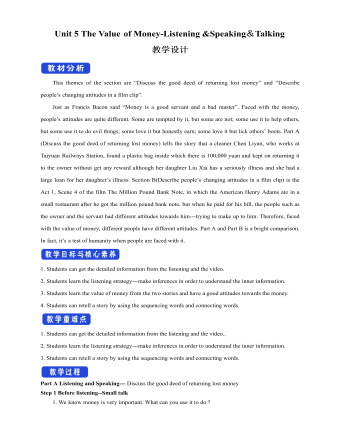
新人教版高中英语必修3Unit 5 The Value of Money-Listening &Speaking&Talking教学设计
4. A:We’d like to have someone to say a word at the beginning to welcome the group.B:↙Who?A:We thought that you or Dr.Johnson might do it.B用降调说Who,其意思是问,对方想让谁在开场时致欢迎词。Step 6 Pronunciation---Practice1. Listen to the short conversation and mark the intonation with ↗, ↙ or ↙, ↗. Then discuss with a partner what they intend to convey by using different intonation.Owner: You know what ?↗ It’s a million-pound bank note↙.Waiter 1: Really ?↗(question)Waiter 2: Really !↙(unbelievable and surprised)Waiter 3: Really ?!↙↗(first question then surprised)2. Listen to the conversations. Underline the parts that are stressed and mark the intonation. Then talk about the implied meanings of the responses with different intonations. Listen again and repeat.1) Henry: It’s a nice suit.Owner: Oh, it’s perfect!↙(The intonation means it is very suitable for Henry.)2) Henry: Well, that’s very kind of you.Owner: Kind, sir ?↗(what you said is not right) No, it’s kind of you. You must come whenever you want and have whatever you like. Just having you sit here is a great honour !!↙(welcome you to come again)3)Henry:Well, to be honest, I have none. Oliver:(happily) What luck!(excited) Brother↗, what luck!↙(It means “Didn’t you hear it?”)Henry: Well, it may seem lucky to you but not to me!↗(angry) If this is your idea of some kind of joke, I don’t think it’s very funny. Now if you’ll excuse me, I ought to be on my way.↙(If so, I would leave.)Roderick: Please don’t go↙...(hope Henry can wait for a moment)Part B Viewing and Talking---Describe people’s changing attitudes in a film clipStep 1 Before-listening---Tell the filmYou are going to watch part of the film The Million Pound Bank Note. Look at these photos and guess what happens in the film.
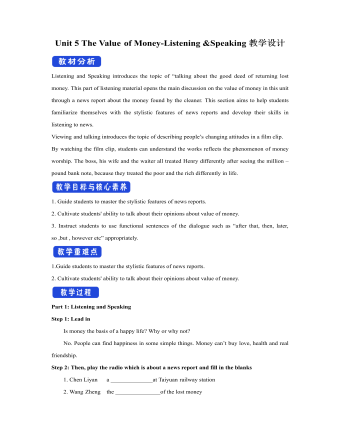
新人教版高中英语必修3Unit 5 The Value of Money-Listening &Speaking教学设计
Step 4: Listen again and decide if the following statements are true (T) or false (F).1 It was the first time Chen Liyan's story was reported. T口 F口2 Chen found 10,000 yuan in a small plastic bag in Taiyuan railway station口 F口3 Wang Zheng apologized to Chen because he couldn't offer her more money. T口 F口4 Chen took out a large loan to cure her daughter, T口 F口5 Wang set up a fundraising website for Chen's daughter after Chen told him about her situation. T口 F口Step 5:After listening, discuss the questions.1 What kind of person do you think Chen Liyan is?Chen Liyan is generous and honest because she returned a large sum of money to the owner.2 Did Chen return the money because she didn't need it?No. She returned the money because it was the right thing to do. Evidence for this is that she refused to accept the reward money because she felt that it had not been earned. 3 Is it common for people to do what Chen did?It depends on the culture. In some countries it is quite common to return money that has been found. In other countries, people believe "Finders are keepers!" 4 How did Wang Zheng feel about the return of his money?He must have been very happy and relieved to have gotten his money back. We know this because he thanked Chen repeatedly and even offered her a reward.5 Why did Ma Dongbao tell Wang about Chen's family?He must have had great sympathy for Chen and her daughter and wanted to help them.'We know this because he arranged help for them. 6 How did the news reporter feel about Chen's actions?The news reporter felt that it showed that money wasn't the most important thing in life. We know this because the reporter told us that this is what Chen believes. and then said, “that's a great attitude to take."
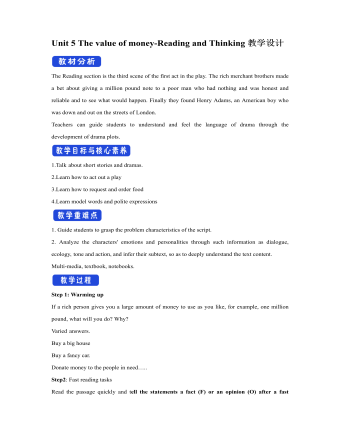
新人教版高中英语必修3Unit 5 The value of money-Reading and Thinking教学设计二
? Could you offer me some kind of work here?? I don’t want your charity, I just want an honest job.? Careless: I landed in Britain by accident.Step 7:Consolidation.? Find Henry? Roderick and Oliver were I .making a bet when they saw Henry, a poor young man. ? Know Henry? About a month ago, Henry was sailing and later he found himself carried out to sea by a strong wind. Fortunately, he 2.was spotted by a ship. And it was the ship that brought him to 3.England? Offer money to Henry ? Oliver and Roderick gave Henry a letter and told him that there was money in it. They 4.persuaded him to accept it, and made him 5.promise that it wouldn't be opened until 2 o'clock.Step 8:Language pointsa large amount of: a large quantity of; a great deal ofe.g. They bought a large amount of furniture before they moved their new house.make a bet: make an arrangement to risk money, etc. on an event of which the result is doubtful.e.g. We made a bet on the result of the match.permit sb to do something: allow somebody to do somethinge.g. My mother doesn’t permit me to ride in the street after it rained.by accident: as a result of chancee.g. I only found it by accident.stare at: look at somebody or something with the eyes wide open in a fixed gaze( in astonishment, wonder, fear, etc)to be honest: to tell you the truth; to be franke.g. To be honest, I don’t think we have a chance of winning.Step7 Homework:What do you think will happen to Henry? Will the bank-note help him or get him into trouble?
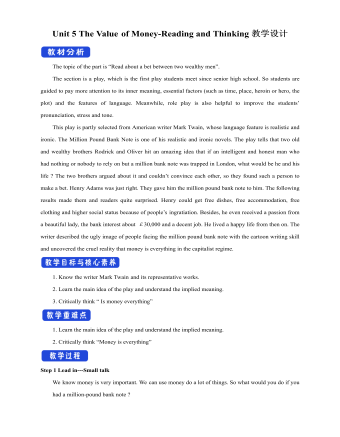
新人教版高中英语必修3Unit 5 The Value of Money-Reading and Thinking教学设计一
Everybody wants to get wealth.In today’s material world,making money or becoming wealthy symbolizes a person’s success and capability. Many people just make every effort, pay any price to attain greater wealth. With money,they can buy nice, large apartments in nice neighborhood. With money they can own luxurious cars. Wealth seems to bring all happiness in life.But is wealth the only road to happiness? Not really. There are many things in the world, which are beyond the means of money, such as friendship, love, health and knowledge. People are so preoccupied with struggling for money that they have no time or would not take the time to form or maintain friendship. What happiness can they feel living as lonely miserable creatures without love or friends in the world even if they accumulate tremendous wealth?In my opinion, people can’t do anything without money, but money is not everything. What money will bring you depends on your personal belief and goal in life. If you are kind enough to help others, especially the poor, money is a good thing to you. With it, you can do much more for the benefit of people and your country, and it will add to your own happiness. If you want money just for your own needs, you’ll never be satisfied or happy. In a word,you should have money spent for more people. Only then can money be the source of your happiness.Step 8 Homework4 students in a group, one acts Roderick, one Oliver, one servant and the fourth one acts Henry Adams, then listen to the tape, pay more attention to the difference between American English and British English in pronunciation, stress, tone.
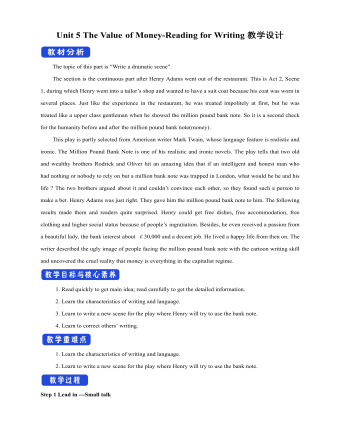
新人教版高中英语必修3Unit 5 The Value of Money-Reading for Writing教学设计二
2. 您能看到, 我头发太长了。You can see that my hair is much too long.3. 无论什么时候, 只要您想回来就回来。Please come back whenever you want.4. 您仅有很少的头发要理! You only have too little hair to cut !5. 为您服务是我的荣幸!It is my honour to serve you!Step 9 Writing(Henry is walking down the street when he sees a sign for a place that cuts hair. He decides to have it cut. )H=Henry B=BarberH: Good afternoon, I’d like to have my hair cut, if I may. (The barber looks at Henry’s hair and continues cutting another man’s hair. ) Er, I’d really like a haircut. As you can see it’s much too long. B: (in a rude manner) Yes, I can see that. Indeed, I can. H: Fine, well, I’ll have a seat then. (He sits in one of the barber’s chairs. The barber turns to look at Henry. )B: It’s quite expensive here, you know! Are you sure you can afford it?H: Yes. I think so. (After his hair is cut, the barber tells Henry how much he must pay. Henry shows the barber the bank note. )B: Why Mr. . . (looks shocked)H: Adams. Henry Adams. I’m sorry. I don’t have any change. B: Please don’t worry! (wearing a big smile) Nothing to worry about! Nothing at all! Please come back whenever you want, even if you only have too little hair to cut! It will be my honour to serve you!Step 10 Pair workExchange drafts with a partner. Use this checklist to help your partner revise his/her draft.1. Are all the elements of a play included and in good order ?2. Do the character use suitable language ?3. Are the stage directions clear and useful ?4. Is the plot clear and exciting enough ?
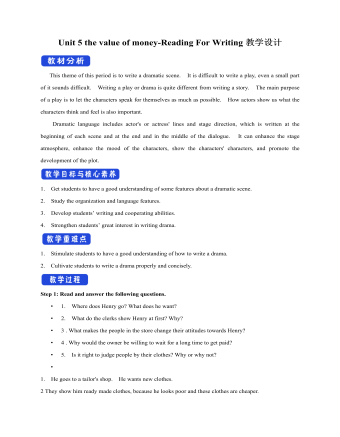
新人教版高中英语必修3Unit 5 the value of money-Reading For Writing教学设计一
【参考范文】Narrator:(Henry is smiling as he leaves the restaurant. As he is walking down the street, he sees a sign for a place that cuts hair. He decides to get it cut. )H=Henry;B=Barber;R=rude manH:Good afternoon, I'd like to get a cut, if I may. (The barber looks at Henry's hair and continues cutting another man's hair. )Er, I'd really like a haircut. As you can see it's much too long. B:(in a rude manner) Yes, I can see that. Indeed, I can. H:Fine, well I'll have a seat then. (He sits in one of the barber's chairs. The barber turns to look at Henry. )B:It's quite expensive here, you know!Are you sure you can afford it?H:Yes. I think so. (In comes the rude man. )R:Hey you there. I need a haircut quickly. Can you do me straightaway?B:All right, then, get in the chair and I'll see what I can do. R:Thank you. (sits down in one of the barber's chairs)H:Excuse me, but I was here first. Aren't you going to do my hair first?B:This man's in a hurry. H:Well so am I!I insist that you cut my hair first. B:OK, but I'll have to be quick. This gentleman is waiting. H:Thank you. (They both become quiet. After his hair is cut, the barber tells Henry how much he must pay. Henry shows the barber the bank note. )B:Why, Mr . . . (looks shocked)H:Adams. Henry Adams. I'm sorry, I don't have any change. R:You're that Mr Adams! Well,I'm glad I waited or I might never have known it was you. B:Why, Mr Adams, please don't worry!(wearing a big smile) Nothing to worry about!Nothing at all!Please come back any time, even if you only need too little hairs cut!It will be my honour to serve you!
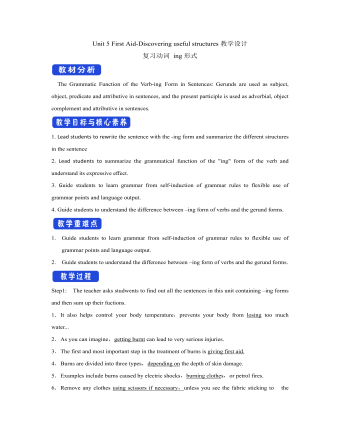
新人教版高中英语选修2Unit 5 First Aid-Discovering useful structures教学设计
You have no excuse for not going.你没有理由不去。He was punished for not having finished his homework.他因未完成作业而受到惩罚。2.动词ing形式复合结构由物主代词或人称代词宾格、名词所有格或普通格加动词ing,即“sb./sb.'s+doing”构成。动词ing形式的复合结构实际上是给动词ing形式加了一个逻辑主语。动词ing形式的复合结构有四种形式:①形容词性物主代词+动词ing②名词所有格+动词ing③代词宾格+动词ing④名词+动词ingHer coming to help encouraged all of us.她来帮忙鼓舞了我们所有人。The baby was made awake by the door suddenly shutting.这个婴儿被突然的关门声吵醒了。Can you imagine him/Jack cooking at home?你能想象他/杰克在家做饭的样子吗?无生命名词无论是作主语还是作宾语都不能用第②种形式。Tom's winning first prize last year impressed me a lot.汤姆去年得了一等奖使我印象深刻。Do you mind my/me/Jack's/Jack leaving now?你介意我/杰克现在离开吗?Excuse me for my not coming on time.很抱歉我没能按时来。His father's being ill made him worried.他父亲病了,他很担心。We are looking forward to the singer's/the singer to give us a concert.我们盼望着这位歌手来给我们举办一场演唱会。
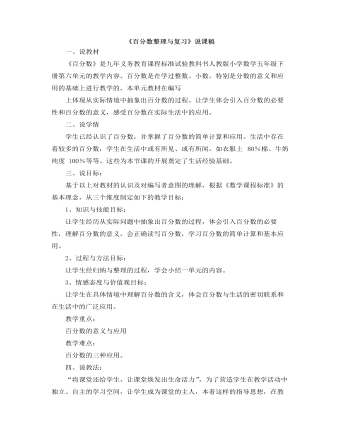
小学数学人教版六年级上册《百分数整理与复习》说课稿
一、说教材《百分数》是九年义务教育课程标准试验教科书人教版小学数学五年级下册第六单元的教学内容。百分数是在学过整数、小数,特别是分数的意义和应用的基础上进行教学的。本单元教材在编写上体现从实际情境中抽象出百分数的过程。让学生体会引入百分数的必要性和百分数的意义,感受百分数在实际生活中的应用。二、说学情学生已经认识了百分数,并掌握了百分数的简单计算和应用。生活中存在着较多的百分数,学生在生活中或有所见、或有所闻。如衣服上 80%棉、牛奶纯度 100%等等。这些为本节课的开展奠定了生活经验基础。
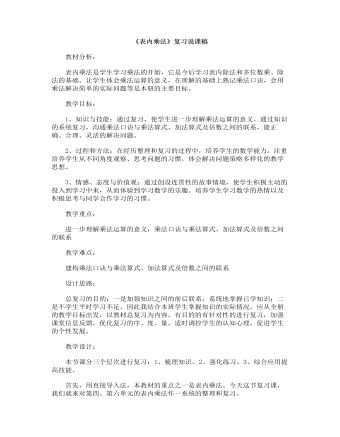
小学数学人教版二年级上册《表内乘法》复习说课稿
教学目标:1、知识与技能:通过复习,使学生进一步理解乘法运算的意义。通过知识的系统复习,沟通乘法口诀与乘法算式、加法算式及倍数之间的联系,能正确、合理、灵活的解决问题。2、过程和方法:在经历整理和复习的过程中,培养学生的数学能力。注重培养学生从不同角度观察、思考问题的习惯,体会解决问题策略多样化的教学思想。3、情感、态度与价值观:通过创设连贯性的故事情境,使学生积极主动的投入到学习中来,从而体验到学习数学的乐趣。培养学生学习数学的热情以及积极思考与同学合作学习的习惯。教学重点:进一步理解乘法运算的意义,乘法口诀与乘法算式、加法算式及倍数之间的联系教学难点:建构乘法口诀与乘法算式、加法算式及倍数之间的联系
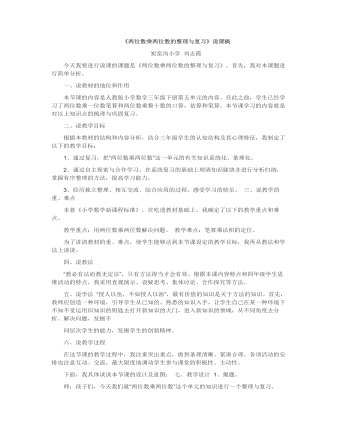
小学数学人教版三年级下册《两位数乘两位数》整理与复习 说课稿
单分析。一、说教材的地位和作用本节课的内容是人教版小学数学三年级下册第五单元的内容。在此之前,学生已经学习了两位数乘一位数笔算和两位数乘整十数的口算,估算和笔算。本节课学习的内容就是对以上知识点的梳理与巩固复习。二、说教学目标根据本教材的结构和内容分析,结合三年级学生的认知结构及其心理特征,我制定了以下的教学目标:1、通过复习,把“两位数乘两位数”这一单元的有关知识系统化、条理化。2、通过自主探索与合作学习,在系统复习的基础上理清知识脉络并进行分析归纳,掌握有序整理的方法,提高学习能力。3、经历独立整理、相互交流、综合应用的过程,感受学习的快乐。 三、说教学的重、难点本着《小学数学新课程标准》,在吃透教材基础上,我确定了以下的教学重点和难点。教学重点:用两位数乘两位数解决问题。 教学难点:笔算乘法积的定位。为了讲清教材的重、难点,使学生能够达到本节课设定的教学目标,我再从教法和学法上谈谈。
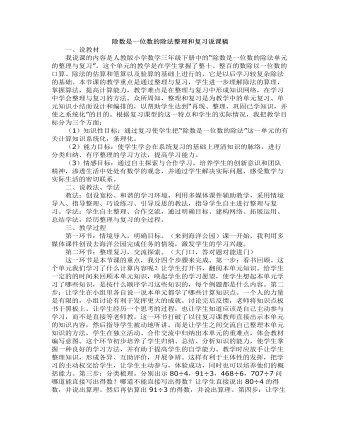
小学数学人教版三年级下册《除数是一位数的除法》整理和复习说课稿
一、说教材我说课的内容是人教版小学数学三年级下册中的“除数是一位数的除法单元的整理与复习”。这个单元的教学是在学生掌握了整十、整百的数除以一位数的口算、除法的估算和笔算以及验算的基础上进行的,它是以后学习较复杂除法的基础。本节课的教学重点是通过整理与复习,学生进一步理解除法的算理,掌握算法,提高计算能力,教学难点是在整理与复习中形成知识网络,在学习中学会整理与复习的方法。众所周知,整理和复习是为教学中的单元复习、单元知识小结而设计和编排的,以帮助学生达到“再现、整理、巩固已学知识,并使之系统化”的目的。根据复习课型的这一特点和学生的实际情况,我把教学目标分为三个方面:(1)知识性目标:通过复习使学生把“除数是一位数的除法”这一单元的有关计算知识系统化,条理化。(2)能力目标:使学生学会在系统复习的基础上理清知识的脉络,进行分类归纳、有序整理的学习方法,提高学习能力。(3)情感目标:通过自主探索与合作学习,培养学生的创新意识和团队精神,渗透生活中处处有数学的观念,并通过学生解决实际问题,感受数学与实际生活的密切联系。
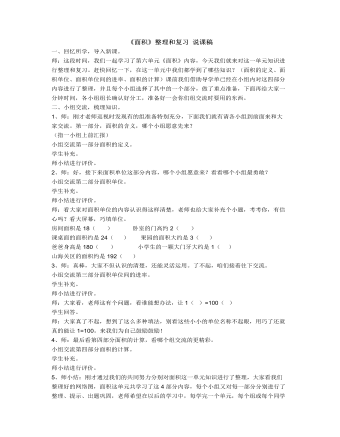
小学数学人教版三年级下册《面积》整理和复习 说课稿
二、小组交流,梳理知识。1、师:刚才老师巡视时发现有的组准备特别充分,下面我们就有请各小组到前面来和大家交流。第一部分,面积的含义,哪个小组愿意先来?(指一小组上前汇报)小组交流第一部分面积的定义。学生补充。师小结进行评价。2、师:好,接下来面积单位这部分内容,哪个小组愿意来?看看哪个小组最勇敢?小组交流第二部分面积单位。学生补充。师小结进行评价。师:看大家对面积单位的内容认识得这样清楚,老师也给大家补充个小题,考考你,有信心吗?看大屏幕,巧填单位。房间面积是18( ) 卧室的门高约2( )课桌面的面积约是24( ) 果园的面积大约是3( )爸爸身高是180( ) 小学生的一颗大门牙大约是1( )山海关区的面积约是192( ) 3、师:真棒,大家不但认识的清楚,还能灵活运用。了不起,咱们接着往下交流。小组交流第三部分面积单位间的进率。学生补充。
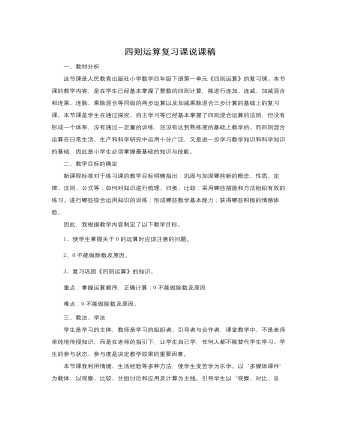
人教版新课标小学数学四年级下册四则运算复习课说课稿
(三)、自主检测 评价完善1、自主检测现在我们要开始攀登主峰了,道路是崎岖的,我相信同学们能够克服重重困难登顶成功,只要细心,你就能行。学生独立完成习题。(设计意图:我这样设计练习,既重视基础知识的训练,又将知识性与趣味性融合为一体,学生兴趣盎然,积极参与。数学课因为有了学生的积极参与而拥有了生命力。)2、评价完善一生汇报答案,其余自我核对,矫正错误。(设计意图:我这样设计练习,既重视基础知识的训练,又将知识性与趣味性融合为一体,学生兴趣盎然,积极参与。数学课因为有了学生的积极参与而拥有了生命力。)(四)、归纳小结 课外延伸1、归纳小结这节课我们主要学习了什么内容?你最大的收获是什么?你觉得自己的表现怎么样?教师适时的对学生的学习情况作以情感性和知识性评价。

人教版新课标小学数学四年级下册有趣的简便运算练习说课稿
学生自己讨论如何比较两道算式的大小,根据时间进行调节,若有时间进行讲解,若无时间留作回家思考的题目。课件在这一环节充分利用了声音,图像等手段,让学生对嘟嘟熊这一朋友有了直观的认识,嘟嘟熊的出现,使本节课又推向了一个新的高潮。这时恰当进行全课总结,颁发礼物的同时又进行了德育渗透,使整节课水到渠成。整节课在教学环节上由一条嘟嘟熊的线索贯穿到底,很自然,顺畅。从基本练习——对比练习——计算练习——巧算总分——比一比,由简到难,而且在每个环节中也都有层次,形成了一个立体的,多维的课堂。在教学中教师始终秉承一个理念:“不同的人在数学上得到不同的发展”。使得这节课在很多环节都体现了算法多样化及合作学习。在教学评价上,本节课很重视师生评价,生生互评,而且评价的方式也多样化,有口头表扬,有贴纸奖励,更有最后的全班评价奖励,可以说整节课都将德育渗透进行到底!
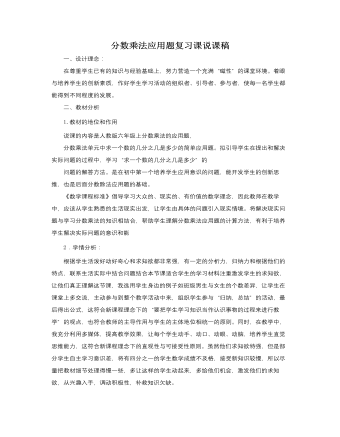
人教版新课标小学数学六年级上册分数乘法应用题复习课说课稿
在尊重学生已有的知识与经验基础上,努力营造一个充满“磁性”的课堂环境。着眼与培养学生的创新素质,作好学生学习活动的组织者、引导者、参与者,使每一名学生都能得到不同程度的发展。二、教材分析1.教材的地位和作用说课的内容是人教版六年级上分数乘法的应用题,分数乘法单元中求一个数的几分之几是多少的简单应用题。拟引导学生在提出和解决实际问题的过程中,学习“求一个数的几分之几是多少”的问题的解答方法。是在初中第一个培养学生应用意识的问题,能开发学生的创新思维,也是后面分数除法应用题的基础。《数学课程标准》倡导学习大众的、现实的、有价值的数学理念,因此教师在教学中,应该从学生熟悉的生活现实出发,让学生由具体的问题引入现实情境。将解决现实问题与学习分数乘法的知识相结合,帮助学生理解分数乘法应用题的计算方法,有利于培养学生解决实际问题的意识和能
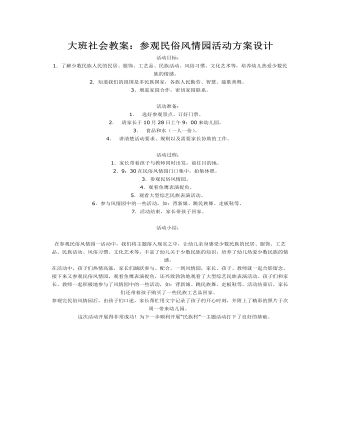
大班社会教案:参观民俗风情园活动方案设计
1.了解少数民族人民的民居、服饰、工艺品、民族活动、风俗习惯、文化艺术等,培养幼儿热爱少数民族的情感。 2.知道我们的祖国是多民族国家,各族人民勤劳、智慧、能歌善舞。 3、增进家园合作,密切家园联系。 活动准备: 1. 选好参观景点、订好门票。 2. 请家长于10月28日上午9:00来幼儿园。 3. 食品和水(一人一份)。 4. 讲清楚活动要求、规则以及需要家长协助的工作。
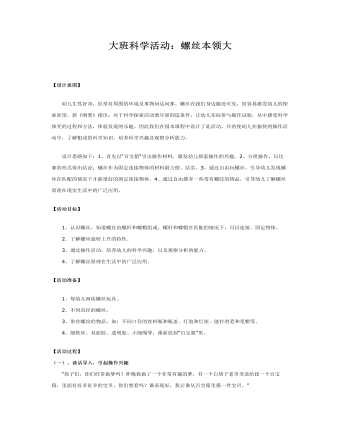
大班科学教案:螺丝本领大
设计思路如下:1、首先以“百宝箱“引出操作材料,激发幼儿探索操作的兴趣。2、分组操作,以比赛的形式得出结论:螺丝作为固定连接物体的材料最方便、结实。3、通过自由玩螺丝,引导幼儿发现螺丝在匹配的情况下才能很好的固定连接物体。4、通过自由摆弄一些带有螺纹的物品,引导幼儿了解螺丝原理在现实生活中的广泛应用。【活动目标】1、认识螺丝,知道螺丝由螺杆和螺帽组成。螺杆和螺帽在匹配的情况下,可以连接、固定物体。2、了解螺丝旋转上升的特性。3、通过操作活动,培养幼儿的科学兴趣,以及观察分析的能力。4、了解螺丝原理在生活中的广泛应用。
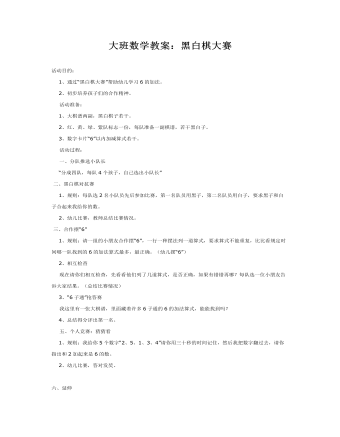
大班数学教案:黑白棋大赛
活动准备: 1、大棋谱两副,黑白棋子若干。 2、红、黄、绿、紫队标志一份,每队准备一副棋谱,若干黑白子。 3、数字卡片“6”以内加减算式若干。 活动过程: 一、分队推选小队长 “分成四队,每队4个孩子,自己选出小队长” 二、黑白棋对抗赛 1、规则:每队选2名小队员先后参加比赛,第一名队员用黑子,第二名队员用白子,要求黑子和白子合起来我给你的数。 2、幼儿比赛,教师总结比赛情况。
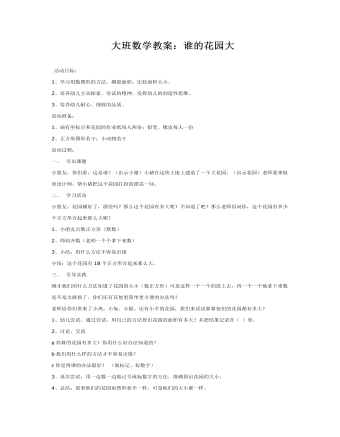
大班数学教案:谁的花园大
2、培养幼儿主动探索、尝试的精神,发挥幼儿的创造性思维。 3、培养幼儿耐心、细致的品质。 活动准备: 1、画有坐标点和花园的作业纸每人两份;铅笔、橡皮每人一份 2、正方形图形若干;小动物若干 活动过程: 一、 引出课题 小朋友,你们看,这是谁?(出示小猪)小猪在这块土地上建造了一个大花园,(出示花园)老师要来做回设计师,帮小猪把这个花园打扮的漂亮一些。 二、 学习活动 小朋友,花园铺好了,漂亮吗?那么这个花园有多大呢?不知道了吧!那么老师再问你,这个花园有多少个正方形合起来那么大呢? 1、小朋友点数正方形(默数) 2、师幼齐数(老师一个个拿下来数) 3、小结:用什么方法不容易出错 小结:这个花园有18个正方形合起来那么大。
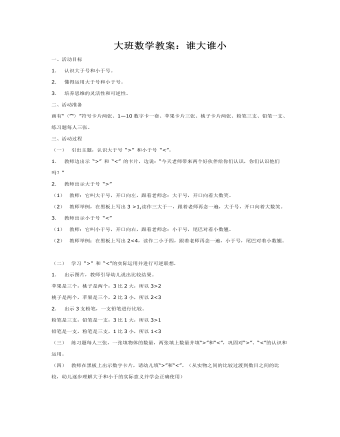
大班数学教案:谁大谁小
二、活动准备 画有“〈”“〉”符号卡片两张、1—10数字卡一套、苹果卡片三张、桃子卡片两张、粉笔三支、铅笔一支、练习题每人三张。 三、活动过程 (一) 引出主题,认识大于号 “>” 和小于号 “<”。 1. 教师边出示 “>” 和 “<” 的卡片,边说:“今天老师带来两个好伙伴给你们认识,你们认识他们吗?” 2. 教师出示大于号 “>” (1) 教师:它叫大于号,开口向左,跟着老师念:大于号,开口向着大数笑。 (2) 教师举例,在黑板上写出3 >1,读作三大于一,跟着老师再念一遍,大于号,开口向着大数笑。 3. 教师出示小于号 “<” (1) 教师:它叫小于号,开口向右,跟着老师念:小于号,尾巴对着小数翘。 (2) 教师举例:在黑板上写出2<4,读作二小于四,跟着老师再念一遍,小于号,尾巴对着小数翘。